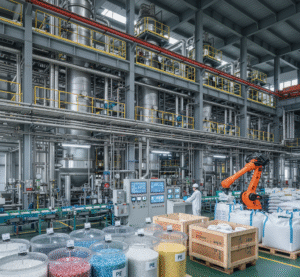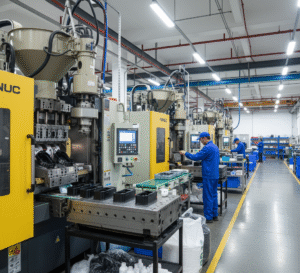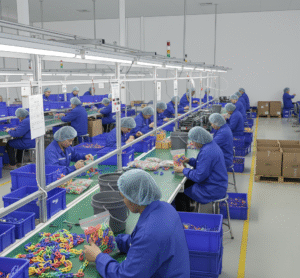Curious about how plastic injection molding works? This guide provides a comprehensive overview of the entire process, from plastic resin and molding machines to the complete industry supply chain. See how the “Chuan Liang Plastic Chain” brings ideas to life.
Have you ever wondered how the everyday plastic products around you—like your phone case, LEGO bricks, or the cap on your water bottle—are made? These items, with their diverse shapes and vibrant colors, all begin their journey with a magical machine in a factory: the thermoplastic injection molding machine.
Today, let’s pull back the curtain on one of the most crucial processes in modern manufacturing and explore the complete story of plastic injection molding, from the process itself to the industry chain that supports it.
What is Thermoplastic Injection Molding? A Simple Guide
In simple terms, plastic injection molding is like a super-sized, industrial version of a hot glue gun. We can visualize the entire process in four steps:
- Melting: Just as you feed a solid glue stick into a hot glue gun, the machine takes solid plastic pellets and heats them until they become a thick, molten liquid.
- Injection: When you pull the trigger on a glue gun, the melted glue is forced out. Similarly, the machine uses immense pressure to “inject” the molten plastic into a sealed metal mold.
- Cooling: The hot glue hardens quickly in the air. Inside the mold, the hot plastic is rapidly cooled by a cooling system, causing it to solidify back into a solid state, taking the shape of the mold.
- Ejection: If you imagine your hot glue being squeezed into a two-part mold, once it cooled, you could open the mold to find a perfect copy. This is the final step, where the mold opens and the finished part is ejected.
The process is built on two core concepts:
- Thermoplastic: This refers to a type of plastic that becomes liquid when heated and solidifies when cooled. This cycle can be repeated, much like water freezing into ice and melting back into water, making it ideal for recycling.
- Injection Molding: This is the technique of injecting molten plastic material under high pressure into a precision-engineered mold, where it cools and hardens to match the mold’s shape.
The Core of the “Chuan Liang Plastic Chain”: The Four-Step Injection Molding Process
At Chuan Liang, the creation of every plastic product follows a highly precise and efficient standard procedure. Inside an injection molding machine, a sophisticated, automated production line carries out these four primary stages:
Plasticization and Melting
The journey starts with raw materials. Plastic pellets, typically translucent or off-white, are mixed with various “additives” in precise ratios according to product specifications. For instance, a high-concentration pigment known as “Color Masterbatch” is added to determine the final color, while “UV additives” can be included to enhance the weather resistance of outdoor products, preventing degradation from sun exposure. The mixture enters the machine through a “hopper” and is fed forward by a “screw.” As the screw rotates, it simultaneously heats and mixes the materials, thoroughly melting the solid pellets and additives into a homogeneous molten paste.
Mold Closing and Injection
While the plastic is melting, two large metal plates of the “mold” close tightly, forming a sealed cavity in the shape of the desired product. The screw then acts like a plunger, injecting the accumulated molten plastic at its tip into the mold cavity with extremely high pressure and speed until it is completely filled.
Holding (Packing) and Cooling
To prevent defects like voids or warping as the plastic cools and shrinks, a sustained “holding pressure” is applied after the initial injection. Concurrently, the mold’s internal cooling channels circulate fluid to rapidly draw heat away from the plastic, allowing it to solidify into its final shape in just a matter of seconds.
Mold Opening and Ejection
Once the part has fully cooled and solidified, the mold automatically opens. The finished product is then pushed out by “ejector pins” and falls onto a conveyor belt below. A perfect replica is now complete, and the cycle repeats continuously to achieve rapid, large-scale production.
The Plastic Industry Chain: From Petroleum to Your Hands
The plastic products we use daily are the result of a vast, collaborative supply chain. A reliable, professional system that connects upstream and downstream partners can be broken down into these key stages:
- Petrochemical Plants: At the top of the supply chain, these facilities refine crude oil to produce raw plastic monomers, which are then polymerized into various types of plastic pellets (resin), such as PP, PE, and ABS.
- Professional Injection Molding Company: Positioned in the middle of the supply chain, this is where designs become reality. These companies purchase resin from raw material suppliers and use their expertise with injection molding machines and precision molds to manufacture custom parts and enclosures for their clients.
- Brand Assembly Plants: At the downstream end, these companies take the plastic components produced by the molding factory and assemble them with other parts, like electronics and metal hardware, to create the final products you see on the market, such as plastic chains or buckets.
- In-Process Sustainability: Reusing Runner Scrap: During injection molding, not all plastic becomes part of the final product. A channel, known as the “runner,” allows the molten plastic to flow into the mold cavities. This runner material solidifies along with the product and becomes scrap. In a cost-effective manufacturing philosophy, many factories place grinders next to the machines to immediately shred this high-quality runner scrap into “regrind” or “recycled material.” This regrind is then mixed with virgin material at a specific ratio, depending on product quality requirements, and reintroduced into the production cycle. This practice significantly reduces waste and embodies the principles of a circular economy, creating value for both the client and the planet.



Post-Processing and Testing: Chuan Liang’s Commitment to Quality
A product isn’t finished once it’s molded. To guarantee quality, the plastic chains undergo a series of rigorous in-house tests:
- Tensile Strength Test: Ensures the structural integrity and durability of the chain.
- Anti-Yellowing Test: Verifies that the product’s appearance remains stable over time, even with exposure to light.
- RoHS (Restriction of Hazardous Substances) Testing: Products are sent for periodic testing to ensure all raw materials comply with the environmental and safety standards of the European Union.
These meticulous steps ensure that every plastic chain produced by Chuan Liang meets the highest quality standards, which is key to earning customer trust and achieving milestones like a 60%+ market share in Japan.
The Next Step in Smart Manufacturing: Chuan Liang’s iMF4.0 Digital Transformation
To enhance production transparency, increase efficiency, and preserve the invaluable experience of veteran technicians, “Chuan Liang” is implementing the iMF4.0 Smart Manufacturing system, giving the factory a digital brain.
The iMF4.0 System: Making the Factory Smarter
This system digitizes the entire production process. Manufacturing parameters that were once manually recorded are now automatically saved to a database, ensuring consistent quality for every production run. The system also monitors machine status in real-time, allowing for immediate detection of anomalies and significantly improving the production yield. This is not just about paperless management; it’s about the digital preservation of expertise.
Smart Meters: Calculating Our Carbon Footprint
Within the iMF4.0 framework, we are installing smart meters on the factory’s biggest energy consumers—each injection molding machine. This enables us to:
- Precisely Trace Energy Consumption: The system can calculate the electricity used to produce each part, making energy usage completely transparent.
- Meet Global Trends: This data is fundamental for calculating the “product carbon footprint,” preparing us for international carbon tariffs and regulations.
- Intelligently Save Energy: The system identifies peak electricity usage periods and helps optimize production schedules to avoid unnecessary energy waste, allowing us to pursue productivity while remaining committed to environmental sustainability.
Conclusion: The Ubiquitous Manufacturing Magic
From a humble plastic pellet to the countless products that define our modern lives, plastic injection molding technology is the beating heart of modern industry. It tirelessly transforms designers’ visions into tangible reality with incredible efficiency and precision.
The next time you pick up a plastic object, take a moment to imagine its fantastic journey through the heat and pressure of an injection molding machine.
Want a closer look at how products are made and featured? Follow our blog for a deep dive into the world of plastic chains.
Email:sales@pinkbrand.com
web:pinkbrand.com
